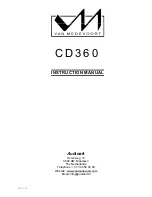
Selenio X100
Installation and Operation Manual
72
ARIB
The X100 reports the current audio mode embedded in the incoming ARIB packet, and has
the ability to replace the field with a different value.
Closed Captioning/Teletext
To make changes to the closed captioning and Teletext settings, select the following
parameters located at
Data Output > Proc Ch x Output > Proc Ch x LN 12-21
:
Proc Ch x TT
Proc Ch x CC
Serial CC
These options are hidden if closed captioning or Teletext are not available.
Based on input and output video standards, the X100 performs the following closed
captioning transcoding:
If the input and output video standards are the same, the X100 de-embeds the CC data
and then re-embeds the data on the output program stream without any transcoding.
If the input format is SD-SDI and the output format is HD-SDI, the X100 transcodes the
analog CC waveform, based on the EIA 608 standard from the SD input stream to
ancillary packets based on the EIA 708 standard.
If the input format is HD-SDI and the output format is SD-SDI, the X100 transcodes the
CC ancillary packets based on the EIA 708 standard from the HD input stream to
analog waveform based on the EIA 608 standard.
Although North America has dedicated standards for closed captioning of video (EIA-608
and 708), many countries in Europe and elsewhere have not yet adopted formal standards.
For these countries, closed captioning is part of the DVB Teletext System as described in
ITU-R BT-653-3. These specifications define all Teletext Systems (A, B, C, D) used in the
world and are also known as the World System Teletext (WST). A Teletext system is made of
several pages of various data information and CC data is described in one these pages.
System B is used in Australia, the UK, and Germany, among other countries.
Australian closed captions are inserted on line 21/334 in analog PAL broadcast signals, as
per the ITU-R BT-653-3. When analog PAL is produced or converted to SDTV (625 digital), a
digitized version of the closed captioning appears on line 21/334 (in the same way line 21
on NTSC signals is digitized and appears on the line 21 of SD-SDI signals). The ITU-R
BT-653-3 document proposed by Free TV Australia indicates how to carry this CC data into
the VANC area of SD-and HD-SDI signals by use of the SMPTE 334M VANC embedding
protocol. For digital broadcasting, Australia intends to use the ETSI EN 300 472 standard
that specifies the conveyance of ITU-R System B Teletext in DVB bit streams.
Setting Teletext
An X100 performs the following Teletext transcoding:
If the input and output video standards are the same, the X100 de-embeds the TT data
and then re-embeds the data on the output program stream without any transcoding.
If the input format is SD-SDI and the output format is HD-SDI, the X100 transcodes the
analog TT waveform based on ITU-R BT.653-3 standard (system B only) from the SD
input stream to ancillary packets based on the Free TV Australia OP47 standard.
Summary of Contents for Selenio X100
Page 8: ...Selenio X100 Installation and Operation Manual viii...
Page 21: ...Selenio X100 Installation and Operation Manual 9 Figure 1 5 X100 Signal Flow...
Page 22: ...Selenio X100 Installation and Operation Manual 10...
Page 38: ...Selenio X100 Installation 26...
Page 158: ...Appendix A Laser Safety Guidelines 146...
Page 178: ...166...
















































